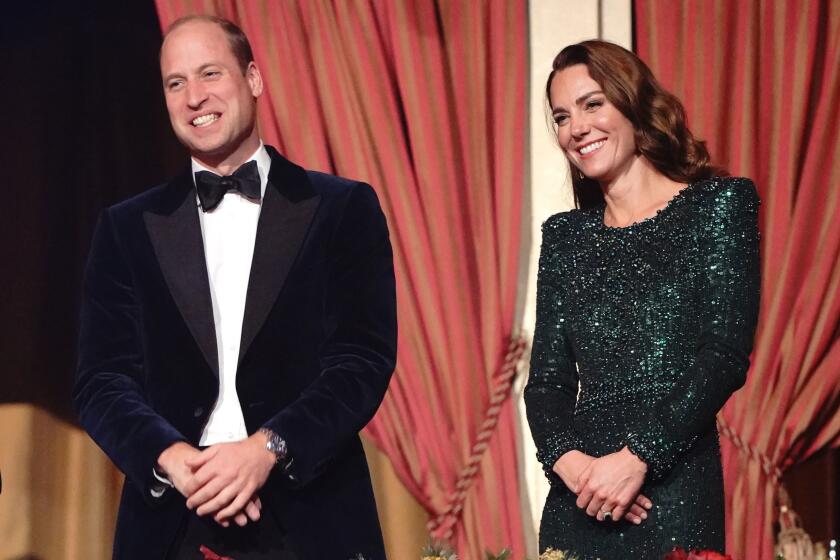Q&A: L.A. artist Marnie Weber reflects on why monsters hold such power for women

WATCH: L.A. artist Marnie Weber’s talks about her L.A. solo exhibition and feature film, “The Day of Forevermore” (Barbara Davidson / Los Angeles Times)
Step into Hollywood’s Gavlak gallery and you’ll find the typical white box transformed into a most surreal chapel. A pair of oversized tree sculptures are crafted from broken bits of stained glass. A large pig meditates before a whooshing waterfall. And a small alcove stuffed with pews displays a film about a witchy gathering in sight of a devil sculpture whose bare bottom hangs through the wall.
Welcome to “Chapel of the Moon,” the latest solo exhibition by Los Angeles artist Marnie Weber, who is known for producing wild multimedia works that often dwell on the ghostly and the monstrous. (Think: Fairy tales gone seriously awry.)
It is the first significant solo show in Los Angeles by the artist in six years. She’s been busy with museum exhibitions in Europe, but now Weber is back with a bang.
Now in its final week, the Gavlak exhibition is also screening the artist’s first feature film, “The Day of Forevermore,” a hypnotic coming-of-age tale that stars the artist’s daughter, Colette Weber Shaw. The actress plays Luna Crimson, a young woman conflicted by the loyalty she feels toward her mother and the desire to leave the devil-infested farm they inhabit. Weber not only directed the film, she wrote it, devised the outlandish costumes and plays the part of Baba Muthra, Luna’s alcohol-addled witch mother.
Weber closes out “Chapel of the Moon” with a special performance Saturday that will feature live music and monsters. (The artist is a long-running experimental musician, known for performing with experimental bands such as the Party Boys and the Spirit Girls.)
In this lightly edited conversation, Weber talks about why she felt the urge to direct, what it was like to work with her teen daughter and why men and women view monsters so differently.
The last time you had a solo exhibition in Los Angeles you were playing a gig at a cemetery.
Yes! Emi Fontana at [the arts nonprofit] West of Rome asked me, “If you had a dream show anywhere in Los Angeles, where would you want it to be?” I said, “The mausoleum right up the street from me in Altadena.” That’s near where my studio was.
I had done research on the graveyard and the people who were buried in the graveyard. I had caretaker guys dressed as gold miners and they took people through the graveyard and pointed out who was buried there. They acted really crazy and drunk. And then the Spirit Girls arrived in an old convertible Cadillac.
I made a film, “The Eternal Heart,” and we projected that in the middle of the mausoleum. The Spirit Girls played the score — a bit like a silent movie. About 500 people came.
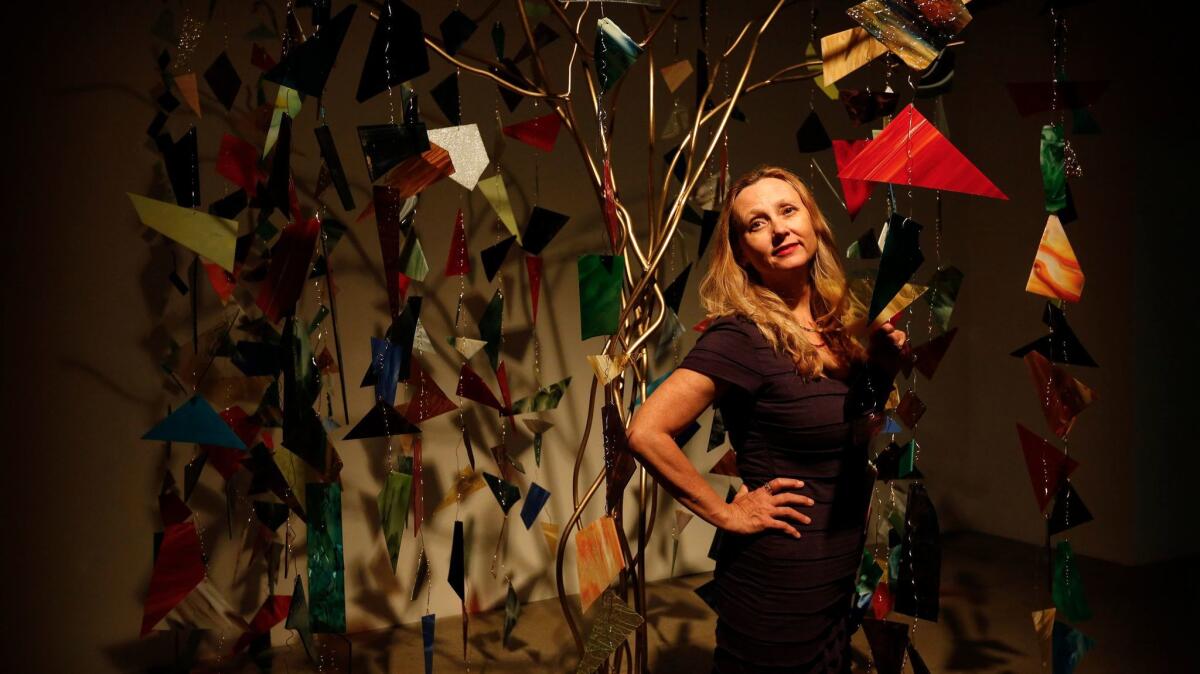
Men don’t see the possibility of being a victim of their monsters. The monster is their alter ego.
— Artist Marnie Weber
You’ve made video throughout your career. What inspired you to take on a feature?
Two years ago, Jack Black invited me to make costumes for Festival Supreme [the annual comedy and art festival held at the Shrine Auditorium]. I made like 21 costumes for monsters and they paraded around the festival. And I had all of these monsters and they were pretty elaborate and I was thinking of these ritual scenes in the [Alejandro] Jodorowsky films and I thought of creating something that was a ritual.
I’ve also wanted to do something very grand — like a dark “Wizard of Oz” — for a long time. I’d been making movies for 22 years and they were all short movies. I wanted to do something on a very big scale. I wanted to have a bit of a homecoming. It was intentional.
Women were ... the healers and thinkers and artists. But [when] someone would call her a witch ... it was a way of denigrating women ... of manipulating people
— Marnie Weber
What did you learn about the difference between making art videos and making full-length features?
You have to be a lot more organized. You have to take on a much stronger personality, a directorial personality. The first day, I showed up with my bullhorn because I don’t speak very loudly. And the guy whose property it was said, “You can’t use a bullhorn.” So I was shouting directions all day. I was pretty hoarse.
And there’s the whole male/female direction thing. We had a lot of technical guys and other guys and they might have taken direction from a woman, but not from someone dressed as an old witch. It’s not the most commanding position to be in. This wasn’t some big independent movie. It’s an art project. There were definitely some rifts, but we pulled it together.
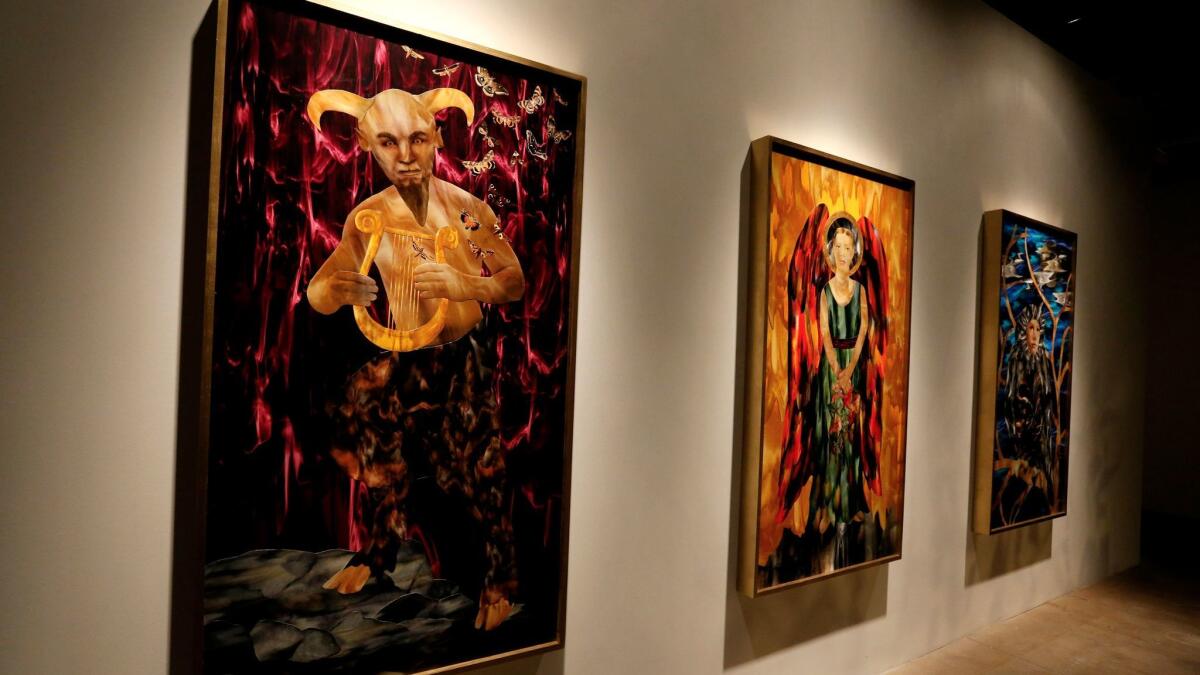
How did you come to cast your daughter in the production?
I wanted a younger version of myself. And the fact that she was a good actress, I thought that was lucky. Colette nailed the character perfectly. Luna is a born innocent — something I hadn’t even really thought about. I just gave her a script and she went with it. It was weird and uncanny to see how she tapped into me as a young character. I was always the young and innocent person who would get swept up in things, who would get easily manipulated.
How was the working relationship between you two?
It was a good working relationship — but there was some eyeball-rolling. That might not have happened if I’d hired an actress. [Laughs.]
I think she developed newfound respect for me. I can come across as a bumbling fool but deep down I know what I’m doing. As a director, you have to make split decisions when you’re filming. I had studied acting; I had made other films, so I knew what it entailed. In a Q&A we did afterward, she said she initially wasn’t aware that there was a big picture in my mind; she thought it was more improvised. But later she realized I had a big picture.
I thought it would be interesting for a woman to fully embrace monsters. Monsters have a male energy.
— Marnie Weber, artist
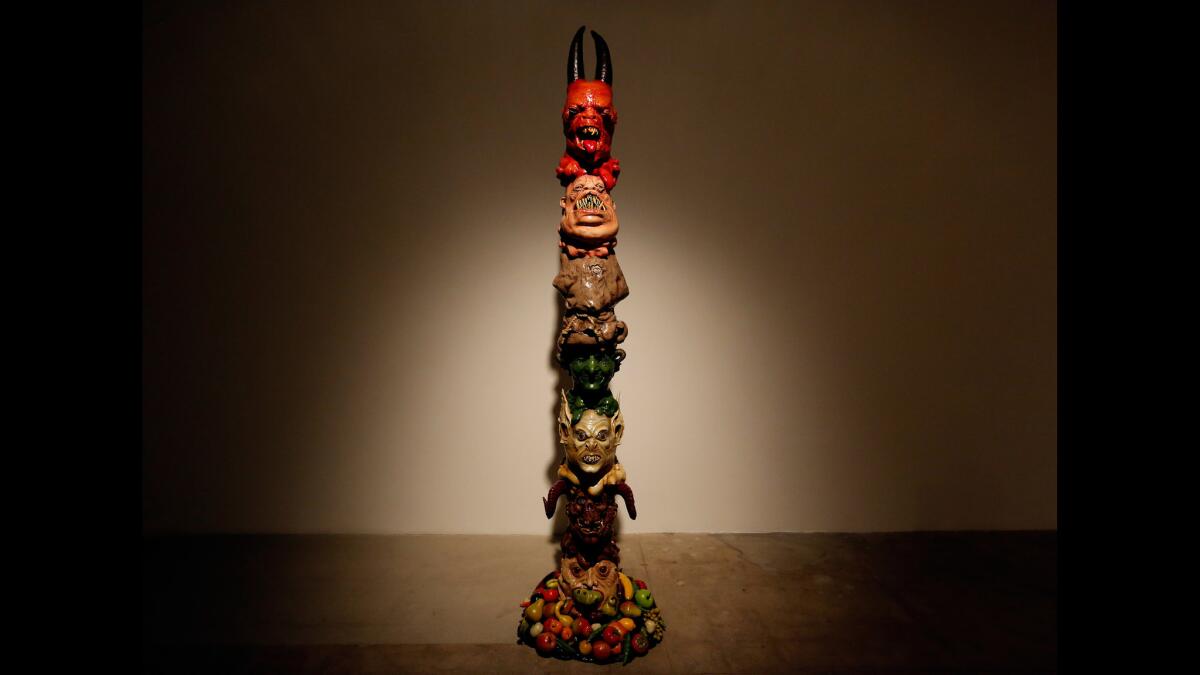
You shot the film on the Zorthian Ranch in Altadena. How did you arrive at that as the ideal location?
I had met Jirayr Zorthian when I worked at the gallery at Otis [College of Art and Design in the late 1980s]. I was the coordinator. And he would come into the gallery. He was a huge personality. He was flamboyant. He would dress flamboyantly. It’s a weird coincidence, but he had a show at the mausoleum in Altadena right before me.
The ranch is this really unique place, with all of these constructions. And the family is constantly dealing with developers and the city and people who would love to have a bunch of condos there.
I got to know Alan [Zorthian’s son]. And I got to know Caroline Zorthian [Alan’s daughter]. They are a lovely family. She plays the Dirty Bunny in the movie. Caroline said to me, “This is the story of my life.” Sometimes she wants to get off the ranch, but it’s her heritage, her place — it’s part of her life.
Your work has long occupied this world of spirits and devils. Why are you so intrigued by monsters? And what types of stories do they allow you to tell?
I grew up in Connecticut and I had an experience where I was out in the woods by myself. In my mind it was nightfall, but I imagine that they weren’t letting me run around the woods at night. It must have been dusk. I imagined that I was being chased by someone with a flashlight. It may have been a dream but it stuck with me. This idea of women being chased by monsters, that’s something I find interesting.
Guys do art about it. Mike Kelley was doing vampires, for example. It’s very different for the men. They don’t see the possibility of being a victim of their monsters. The monster is their alter ego.
But I thought it would be interesting for a woman to fully embrace monsters. Monsters have a male energy — even though I do a lot of female monsters. So for me it’s that idea of befriending what you’re afraid of on a metaphorical level. You can’t become a victim of the monster if you are their leader. My monsters might come across as scary, but they’re really big babies. They want to be told what to do.
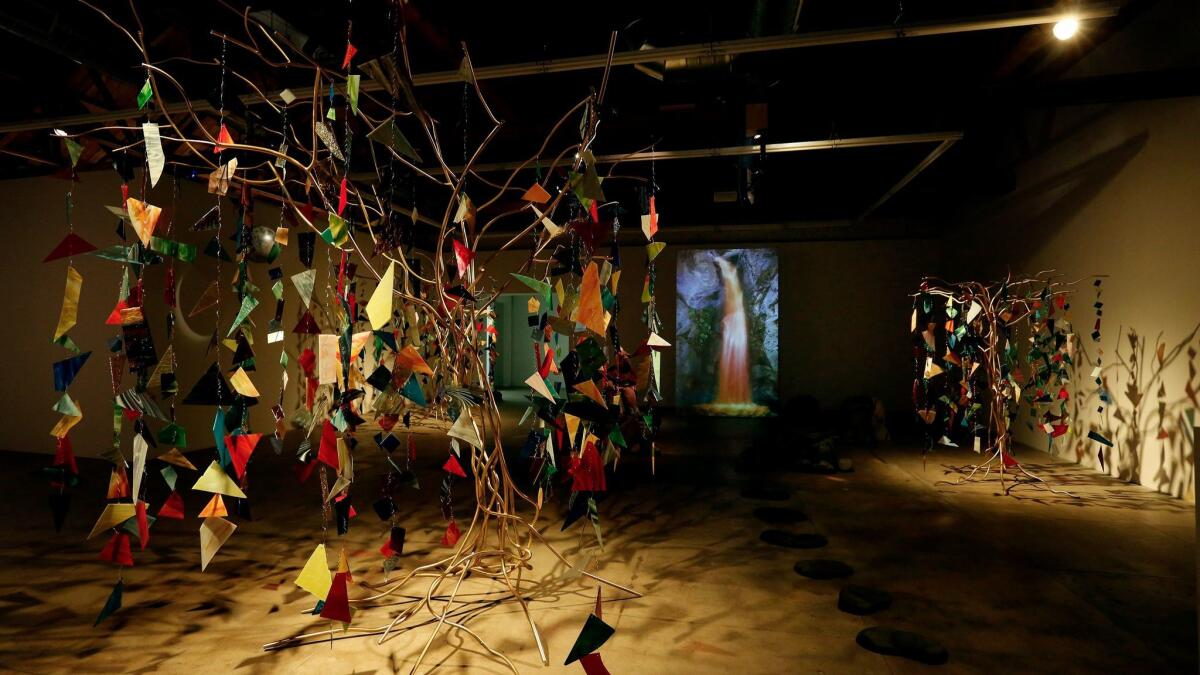
You also play with the concept of the witch.
The whole history of the witch was an untapped thing for me — of women just being abused by men. Women were burned at the stake. They were the healers and thinkers and artists. But often someone would call her a witch so they could torture and rape her. I think the designation was a way of denigrating women. It was a way of pitting villagers against each other, of manipulating people.
How does the installation in the gallery connect with the film?
I was thinking that if Luna were to flee the farm, what would be the next chapter in her life? I thought it might be interesting if she came across a pagan chapel. So I created a place where she could sit and recover from this experience.
I thought of many different ways of expressing this. On EBay you can buy boxes of stained glass remnants, so I thought it’d be interested to hang them as weeping willows — a metaphor of creating something new out of something broken. [Luna’s] broken core was torn out by her witch of a mother and she has to reclaim herself.
There is also a waterfall. I created a soundscape for it. Instead of real water, it’s people whispering, “Slow down.”
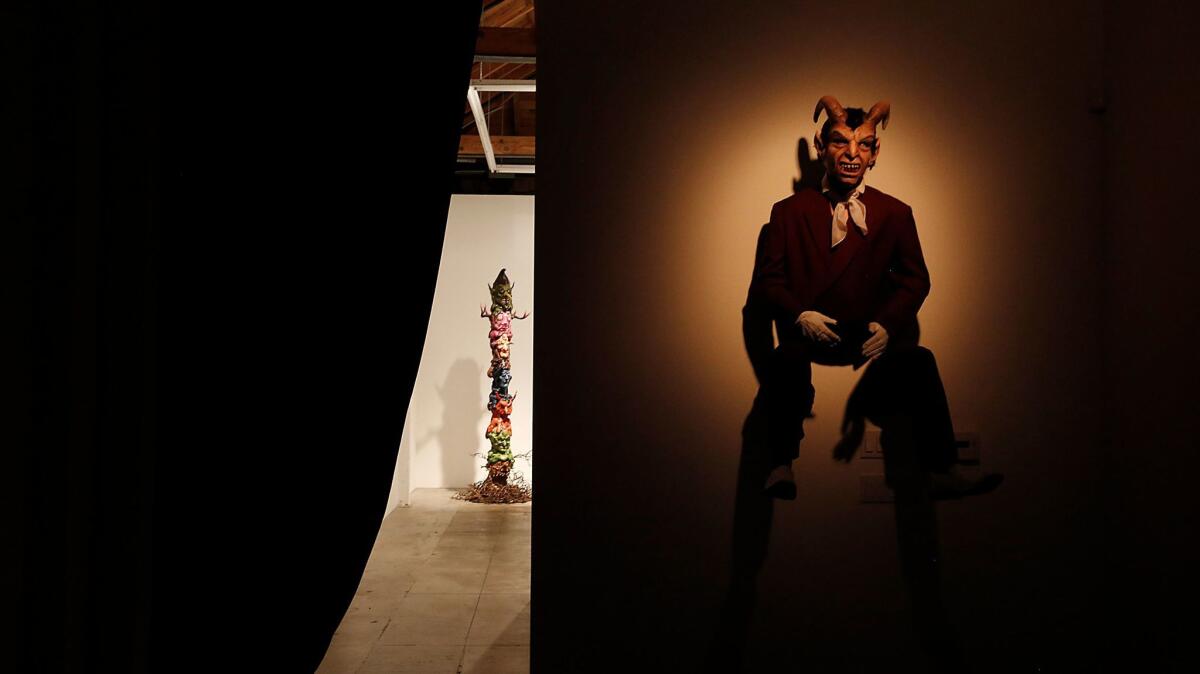
You’ve transformed the gallery into something that really feels like a chapel, complete with pews. Do you ever think about doing larger-scale architectural installations?
It’d be great to get some land and create an architectural permanent chapel somewhere. As an older artist, I think about what I’m leaving behind. It’s not so much chasing a carrot anymore. It’s about leaving a carrot behind you.
-----------
“Marnie Weber: Chapel of the Moon”
Where: Gavlak, 1034 N. Highland Ave., Hollywood
When: Ends Saturday, with a special closing-night soundscape performance by Marnie Weber and Daniel Hawkins from 5 to 6 p.m.
Info: gavlakgallery.com
Sign up for our weekly Essential Arts & Culture newsletter »
Find me on Twitter @cmonstah.
ALSO
What happens when two artists move into an unfinished museum for 10 days of ‘Performance Lessons’
‘A practical solution to a horrific problem’: When even Los Angeles needed havens for black drivers
More to Read
The biggest entertainment stories
Get our big stories about Hollywood, film, television, music, arts, culture and more right in your inbox as soon as they publish.
You may occasionally receive promotional content from the Los Angeles Times.











